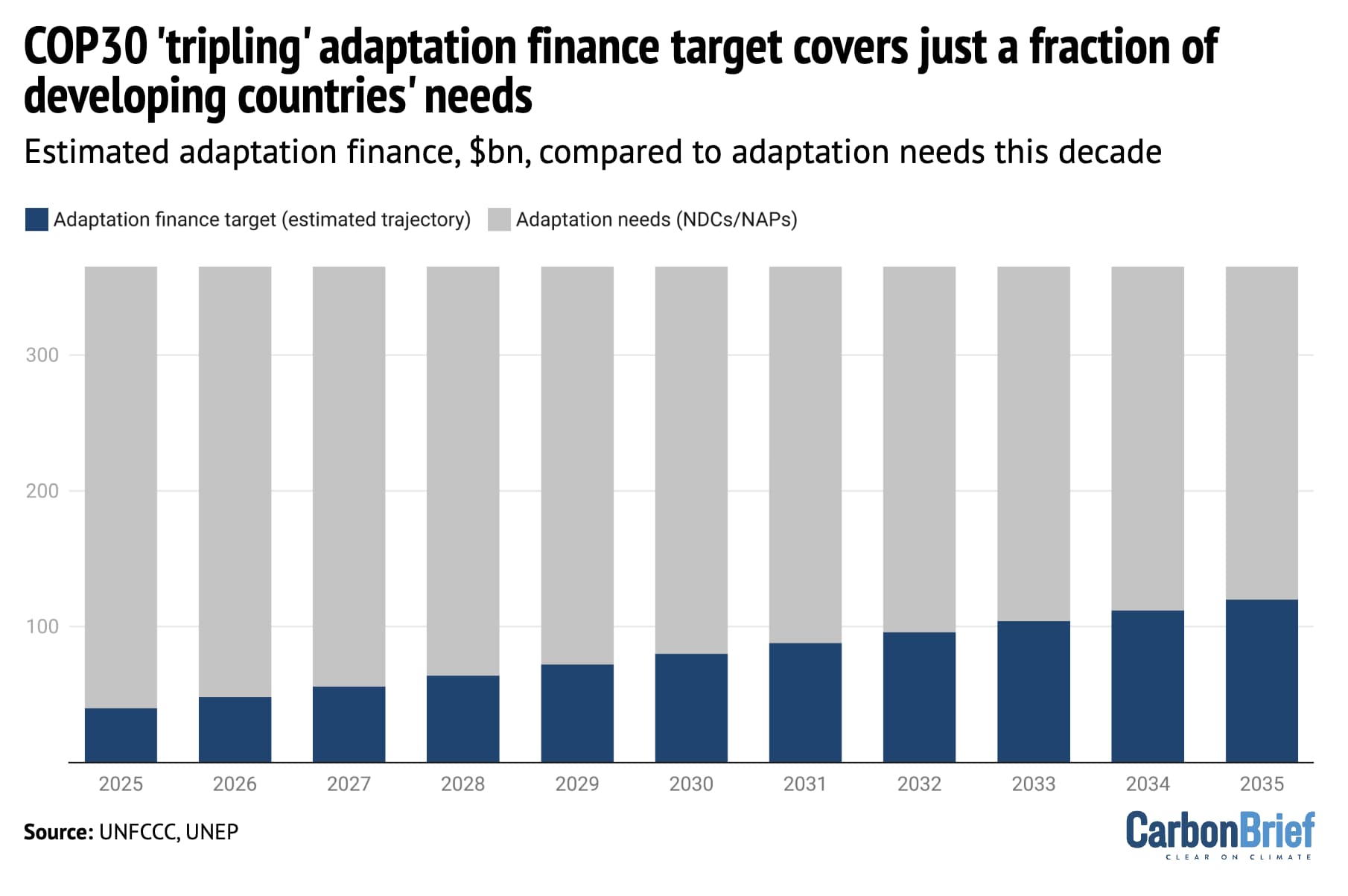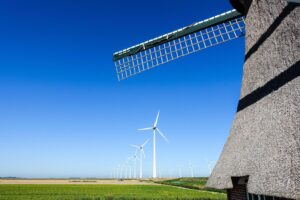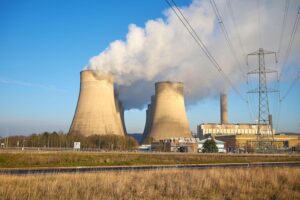There is a “massive gap between rhetoric and reality” that must be closed by new climate pledges being drafted under the Paris Agreement, the UN Environment Programme (UNEP) says.
In the 15th edition of its annual “emissions gap” report, the UNEP calls for “no more hot air” as countries approach the February 2025 deadline to submit their next nationally determined contributions (NDCs) setting mitigation targets for 2035.
These NDCs “must deliver a quantum leap in ambition in tandem with accelerated mitigation action in this decade”, the report says.
The report charts the “gap” between where emissions are headed under current policies and commitments over the coming decade, compared to what is needed to meet the Paris goal of limiting global warming to “well below” 2C and pursuing efforts to stay under 1.5C.
It highlights that greenhouse gas emissions reached record levels in 2023, up 1.3% from 2022, and rising notably faster than the average over the past decade.
The report warns that both progress and ambition have “plateaued” in recent years, with relatively little of substance occurring since the pledges made at COP26 in 2021. And many countries are not even on track to meet their existing NDCs, with current policy projections from G20 nations exceeding NDC commitments by a collective 1bn tonnes of greenhouse gas emissions (in carbon dioxide equivalent, CO2e) in 2030.
Current policies put the world on track for 2.9C of warming by 2100, the report finds – though this could be reduced to 2.4-2.6C, if all existing NDCs are met.
But unless global emissions in 2030 are brought below the levels implied by current NDCs, a pathway to 1.5C with no or limited overshoot becomes “impossible”, the report says, and “strongly” increases the challenge of limiting warming to 2C.
While the magnitude of the challenge is “indisputable”, there are “abundant opportunities for accelerating mitigation”, the report says. It finds that global emissions could be cut by 54% by 2030 and 72% by 2035 at a cost of less than $200 per tonne of CO2.
This indicates that the gap between commitments and current policies is a result of a lack of policy support rather than more fundamental barriers to decarbonisation.
(For previous reports, see Carbon Brief’s detailed coverage in 2014, 2015, 2016, 2017, 2018, 2019, 2020, 2021, 2022 and 2023.)
Global greenhouse gas emissions at record levels
The UNEP report finds that human emissions of greenhouse gases – CO2, methane, nitrous oxide and fluorinated gases (F-gases) – reached a record 57.1bn tonnes of CO2 equivalent (GtCO2e) in 2023.
The chart below shows how fossil CO2 (black) is by far the largest contributor to annual emissions and the main driver of the increase in recent decades, with methane (grey) playing the second largest role.

Global emissions grew 1.3% (0.7 GtCO2e) in 2023, compared with 2022 levels – a rate notably faster than that over the prior decade (2010-19, at 0.8 GtCO2e per year).
(As the report notes, these numbers do not include many of the climate-related impacts on greenhouse gas emissions that are not a result of direct human interventions – such as the catastrophic Canadian wildfires in 2023. The ability of the biosphere to absorb a portion of human emissions is broadly expected to weaken under scenarios where the world does not rapidly reduce emissions.)
These emissions were driven by energy use, industrial process emissions and land-use change across a variety of sectors.
As the chart below shows, electricity generation was the largest driver of greenhouse gas emissions globally in 2023, responsible for approximately 26% of the total. Other major contributors were transportation (15%), industry (11%), fossil-fuel production (10%) and industrial processes (9%).

The report finds that global aviation had the largest relative increase in emissions, increasing 19.5% between 2022 and 2023 as the sector recovered from Covid-era lows. Fossil-fuel production emissions, road transportation and industrial process emissions also increased notably from 2022.
The authors note that the fossil share of generation is starting to decrease in the power sector as solar and wind expand rapidly, with capacity additions increasing by 50% in 2023. Global investment in renewable power, grids and storage is now considerably higher than global investment in oil, gas and coal.
Despite rapid growth in clean energy, power-sector emissions have yet to peak, with new clean additions globally not quite keeping up with the rate of demand growth. However, the report notes that both power-sector emissions and overall global greenhouse emissions are expected to peak in the next few years, even if they did not in 2023.
An even wider emissions gap
The primary focus of this edition of the report is tracking the gap between where the world is heading today – both under current policies and near-term commitments – and what would be needed to meet Paris Agreement goals of limit warming to well-below 2C.
However, since the 2023 report, there have not been any notable changes in country pledges or policies – and global emissions continued to grow.
This means that the emissions gap is wider than it was last year and the world is further off track from its climate goals.
The report explores a number of different future emissions scenarios including: those under policies in place today; emissions if Paris Agreement NDCs are met; emissions if both NDCs and national-level net-zero pledges are met; and emissions required under scenarios that limit warming to below 2C and to 1.5C with no or limited overshoot by 2100.
While these NDCs – alongside other policies enacted by countries – have helped move the world away from some of the darkest climate futures that seemed plausible a decade ago, the gap continues to grow between where the world is today and a path to meeting the Paris Agreement.
The report finds an emissions gap in 2030 of around 14GtCO2e between where the world is headed if countries achieve their “unconditional” NDCs (that is, those not conditioned on “climate finance” or other external assistance) – shown by the mid-blue line – and an emissions pathway that limits warming to below 2C (defined in the report as a >66% chance of avoiding 2C warming) – shown by as the pale red line.
The gap is even larger – around 22GtCO2e – between unconditional NDCs and a scenario consistent with limiting warming to 1.5C by the end of the century (red line). If conditional NDCs are fully implemented in addition to unconditional ones (light blue line), this emissions gap would shrink by around 3GtCO2e in 2030 for both the 2C and 1.5C scenarios.

If NDCs are not strengthened by 2035, this gap would grow to 18GtCO2e for keeping warming below 2C and 29GtCO2e for 1.5C, the report finds. In the absence of a ratcheting up of commitments in recent years, limiting warming to 1.5C with no or low overshoot is now much more difficult to achieve. Further delays could similarly imperil the 2C target.
In addition, many countries are “not even on track to deliver on their current NDCs” today, the report says. Major countries, including Australia, Brazil, Canada, Indonesia, Japan, South Korea, the UK and the US, are all off track to meet their targets under existing policies. (Several of those that are on track had set weak targets, it adds.)
Countries are expected to update their NDCs by February 2025 and these should include mitigation targets up to the end of 2035 (compared to the 2030 date for the initial round of Paris NDCs).
However, the ability of post-2030 commitments to put the world on track to limit warming to below 2C is highly dependent on action pre-2030. As the report shows, strong climate action starting in 2024 would require a 4% reduction per year on average, while doing so in 2030 would increase this to 8% per year.
An upward revision of current policy warming
The UNEP report author team has been one of the main groups assessing the range of warming impacts the world could expect under current policies. However, their estimate has continued to increase over the past three reports – from 2.6C in 2022 to 2.7C in 2023 and 2.9C in 2024. This reflects both continued increases in global greenhouse gas emissions and methodology updates by UNEP.
The figure below compares these estimates between the 2022 (dark blue) 2023 (mid blue blue) and 2024 (light blue) versions of the UNEP report. Compared to the 2023 report, current policy warming outcomes increased notably, unconditional NDC outcomes were unchanged, conditional NDC warming increased slightly, and net-zero pledge warming decreased slightly.

The report finds that a continuation of current policies would result in a 100% chance of exceeding 1.5C, a 97% chance of exceeding 2C and a 37% chance of exceeding 3C by 2100. (And the world will continue to warm after 2100 as long as CO2 emissions remain above (net) zero.)
Under NDCs, the odds of exceeding 1.5C remains at 100%, while there is a 94% chance of exceeding 2C by 2100 under unconditional NDCs and a 79% chance under conditional NDCs.
If all country net-zero pledges are implemented (which, the report notes, few, if any, countries are on track to achieve today), these likelihoods are reduced to a 77% chance of exceeding 1.5C, a 20% chance of exceeding 2C and a near-zero chance of exceeding 3C.
The figure below compares the latest UNEP estimates (mid blue bars) to others in the literature – the emissions scenarios featured in the Intergovernmental Panel on Climate Change’s (IPCC) sixth assessment report (dark blue), estimates published by Climate Action Tracker (light blue), and the IEA’s 2024 World Energy Outlook (grey).

Current policy outcomes are broadly in-line with the IPCC’s middle-of-the-road SSP2-4.5 scenario, though a notable gap has developed in recent years between UNEP and IEA estimates. While the three were nearly identical in 2021, the UNEP’s current policy warming estimate has increased while the IEA’s has decreased.
The UNEP provides a high-end warming estimate for its scenarios that is notably higher than that of other groups. This is because its approach includes both future emissions uncertainties associated with each scenario, plus the range of possible climate system responses from climate sensitivity and carbon cycle feedbacks. While the latter can be expressed probabilistically, the likelihood of future emissions outcomes under these scenarios are more difficult to assess.
High potential for deep emissions cuts
While countries are far from being n track to meet Paris Agreement goals today, the new report explores what it would entail – and cost – to close the emissions gap.
They find that, across all sectors of the economy, global emissions could be reduced by 31GtCO2e by 2030 (54% below current policy levels) for a cost of less than $200 per tonne of CO2. In 2035 this increases to 41GtCO2e (a 72% reduction from current policy levels), reflecting expected continued cost declines of mitigation technologies.
The figure below, taken from the report, shows the assessed mitigation potential for $200 per tonne of CO2 or below for each different sector of the economy.

The energy sector has the largest potential for low-cost decarbonisation at 12GtCO2e/yr in 2030 and 15GtCO2e/yr in 2035, largely driven by the replacement of fossil fuel electricity production with clean energy sources.
Agriculture, forestry and other land uses (AFOLU sector) have the second largest potential for decarbonisation, with forestry making up the largest component of this.
While substantial increases in investments and finance are required to accelerate mitigation across all of these sectors, the report shows that deep decarbonisation is achievable in the next decade at a reasonable cost.
Ultimately, the report highlights that the growing emissions gap reflects a lack of political will by countries to address emissions, rather than any fundamental constraint on the world’s ability to rapidly mitigate.
The post UNEP: New climate pledges need ‘quantum leap’ in ambition to deliver Paris goals appeared first on Carbon Brief.
UNEP: New climate pledges need ‘quantum leap’ in ambition to deliver Paris goals
Greenhouse Gases
Our Fix Our Forests advocacy in 2025
Our Fix Our Forests advocacy in 2025
By Elissa Tennant
Healthy forests are a key part of the climate puzzle — and they’ve been a big part of our advocacy in 2025!
In January of this year, CCL volunteers sent 7,100 messages to Congress urging them to work together to reduce wildfire risk. Soon after, the Fix Our Forests Act was introduced in the House as H.R. 471 and passed the House by a bipartisan vote of 279–141.
At our Conservative Climate Conference and Lobby Day in March, we raised the Fix Our Forests Act as a secondary ask in 47 lobby meetings on Capitol Hill. The next month, an improved version of the bill was then introduced in the Senate as S. 1462 and referred to the Senate Agriculture Committee.
The bill was scheduled for a committee vote in October. CCLers placed more than 2,000 calls to senators on the committee and generated a flurry of local media in their states before the vote. In October, the bill passed the Senate Agriculture Committee with strong bipartisan support.
It’s clear that this legislation has momentum! As the Fix Our Forests Act now awaits a floor vote in the Senate, let’s take a look back at our 2025 advocacy efforts to advance this bill — and why it’s so important.
Protecting forests and improving climate outcomes
Wildfires are getting worse. In the U.S., the annual area burned by wildfires has more than doubled over the past 30 years. In California alone, the acreage burned by wildfires every year has more than tripled over the past 40 years.
American forests currently offset 12% of our annual climate pollution, with the potential to do even more. We need to take action to reduce wildfire, so forests can keep doing their important work pulling climate pollution out of the atmosphere.
The bipartisan Fix Our Forests Act:
- Protects America’s forests by supporting time-tested tools, like prescribed fire and reforestation, that make our forests healthy and able to better withstand and recover from severe wildfire and other extreme weather.
- Protects communities across the nation by reducing wildfire risks to people, homes, and water supplies and adopting new technologies.
- Protects livelihoods by supporting rural jobs and recreation areas and sustaining the forests that house and feed us.
CCL supports this bill alongside many organizations including American Forests, The Nature Conservancy, Environmental Defense Fund, National Audubon Society, The Western Fire Chiefs Association, The Federation of American Scientists and more.
A deeper dive into our efforts
All year long, CCL’s Government Relations staff has been in conversation with congressional offices to share CCL’s perspective on the legislation and understand the opportunities and challenges facing the bill. Our Government Relations team played a key role in helping us understand when and how to provide an extra grassroots push to keep the bill moving.
Starting Sept. 9 through the committee vote, CCLers represented by senators on the Senate Agriculture Committee made 2,022 calls to committee members in support of FOFA. CCL also signed a national coalition letter to Senate leadership in support of the bill, joining organizations like the American Conservation Coalition Action, Bipartisan Policy Center Action, the International Association of Fire Chiefs, and more.
In October, we launched a local media initiative in support of FOFA, focused on states with senators on the Agriculture Committee. Volunteers published letters to the editor and op-eds in California, Minnesota, Colorado, and more. In one state, the senator’s office saw a CCLer’s op-ed in the local newspaper, and reached out to schedule a meeting with those volunteers to discuss the bill! CCL’s Government Relations team joined in to make the most of the conversation.
As soon as the committee vote was scheduled for October 21, our Government Relations staff put out a call for volunteers to generate local endorsement letters from trusted messengers. CCL staff prepared short endorsement letter templates for each state that chapters could personalize and submit to their senator’s office. Each version included clear instructions, contact info, and space for volunteers to add their local context, like a short story or relevant example of how wildfires have impacted their area.
Then, CCL state coordinators worked with the CCL chapters in their states to make sure they prepared and sent the signed letters to the appropriate senate office, and to alert CCL’s Government Affairs staff so they could follow up and keep the conversation going on Capitol Hill.
Individually, our voices as climate advocates struggle to break through and make change. But it’s this kind of coordinated nationwide effort, with well-informed staff partnering with motivated local volunteers, that makes CCL effective at moving the needle in Congress.
On October 21, the Fix Our Forests Act officially passed the Senate Agriculture Committee with a vote of 18-5.
Building on the momentum
After committee passage, FOFA is now waiting to be taken up by the full Senate for a floor vote. It’s not clear yet if it will move as a standalone bill or included in a package of other legislation.
But to continue building support, we spent a large portion of our Fall Conference training our volunteers on the latest information about the bill, and we included FOFA as a primary ask in our Fall Lobby Week meetings.
Volunteers are now messaging all senators in support of FOFA. If you haven’t already, add your voice by sending messages to your senators about this legislation. With strategy, organization, and a group of dedicated people, we can help pass the Fix Our Forests Act, reducing wildfire risk and helping forests remove more climate pollution.
Help us keep the momentum going! Write to your Senator in support of the Fix Our Forests Act.
The post Our Fix Our Forests advocacy in 2025 appeared first on Citizens' Climate Lobby.
Greenhouse Gases
DeBriefed 5 December: Deadly Asia floods; Adaptation finance target examined; Global south IPCC scientists speak out
Welcome to Carbon Brief’s DeBriefed.
An essential guide to the week’s key developments relating to climate change.
This week
Deadly floods in Asia
MOUNTING DEVASTATION: The Associated Press reported that the death toll from catastrophic floods in south-east Asia had reached 1,500, with Indonesia, Sri Lanka and Thailand most affected and hundreds still missing. The newswire said “thousands” more face “severe” food and clean-water shortages. Heavy rains and thunderstorms are expected this weekend, it added, with “saturated soil and swollen rivers leaving communities on edge”. Earlier in the week, Bloomberg said the floods had caused “at least $20bn in losses”.
CLIMATE CHANGE LINKS: A number of outlets have investigated the links between the floods and human-caused climate change. Agence France-Presse explained that climate change was “producing more intense rain events because a warmer atmosphere holds more moisture and warmer oceans can turbocharge storms”. Meanwhile, environmental groups told the Associated Press the situation had been exacerbated by “decades of deforestation”, which had “stripped away natural defenses that once absorbed rainfall and stabilised soil”.
‘NEW NORMAL’: The Associated Press quoted Malaysian researcher Dr Jemilah Mahmood saying: “South-east Asia should brace for a likely continuation and potential worsening of extreme weather in 2026 and for many years.” Al Jazeera reported that the International Federation of Red Cross and Red Crescent Societies had called for “stronger legal and policy frameworks to protect people in disasters”. The organisation’s Asia-Pacific director said the floods were a “stark reminder that climate-driven disasters are becoming the new normal”, the outlet said.
Around the world
- REVOKED: The UK and Netherlands withdrew $2.2bn of financial backing from a controversial liquified natural gas (LNG) project in Mozambique, Reuters reported. The Guardian noted that TotalEnergies’ “giant” project stood accused of “fuelling the climate crisis and deadly terror attacks”.
- REVERSED: US president Donald Trump announced plans to “significantly weaken” Biden-era fuel efficiency requirements for cars, the New York Times said.
- RESTRICTED: EU leaders agreed to ban the import of Russian gas from autumn 2027, the Financial Times reported. Meanwhile, Reuters said it is “likely” the European Commission will delay announcing a plan on auto sector climate targets next week, following pressure to “weaken” a 2035 cut-off for combustion engines.
- RETRACTED: An influential Nature study that looked at the economic consequences of climate change has been withdrawn after “criticism from peers”, according to Bloomberg. [The research came second in Carbon Brief’s ranking of the climate papers most covered by the media in 2024.]
- REBUKED: The federal government of Canada faced a backlash over an oil pipeline deal struck last week with the province of Alberta. CBC News noted that First Nations chiefs voted “unanimously” to demand the withdrawal of the deal and Canada’s National Observer quoted author Naomi Klein as saying that the prime minister was “completely trashing Canada’s climate commitments”.
- RESCHEDULED: The Indonesian government has cancelled plans to close a coal plant seven years early, Bloomberg reported. Meanwhile, Bloomberg separately reported that India is mulling an “unprecedented increase” in coal-power capacity that could see plants built “until at least 2047”.
$518 billion a year
The projected coastal flood damages for the Asia-Pacific region by 2100 if current policies continue, according to a Scientific Reports study covered this week by Carbon Brief.
Latest climate research
- More than 100 “climate-sensitive rivers” worldwide are experiencing “large and severe changes in streamflow volume and timing” | Environmental Research Letters
- Africa’s forests have switched from a carbon sink into a source | Scientific Reports
- Increasing urbanisation can “substantially intensify warming”, contributing up to 0.44C of additional temperature rise per year through 2060 | Communications Earth & Environment
(For more, see Carbon Brief’s in-depth daily summaries of the top climate news stories on Monday, Tuesday, Wednesday, Thursday and Friday.)
Captured

A new target for developed nations to triple adaptation finance by 2035, agreed at the COP30 climate summit, would not cover more than a third of developing countries’ estimated needs, Carbon Brief analysis showed. The chart above compares a straight line to meeting the adaptation finance target (blue), alongside an estimate of countries’ adaptation needs (grey), which was calculated using figures from the latest UN Environmental Programme adaptation gap report, which were based on countries’ UN climate plans (called “nationally determined contributions” or NDCs) and national adaptation plans (NAPs).
Spotlight
Inclusivity at the IPCC
This week, Carbon Brief speaks to an IPCC lead author researching ways to improve the experience of global south scientists taking part in producing the UN climate body’s assessments.
Hundreds of climate scientists from around the world met in Paris this week to start work on the Intergovernmental Panel on Climate Change’s (IPCC’s) newest set of climate reports.
The IPCC is the UN body responsible for producing the world’s most authoritative climate science reports. Hundreds of scientists from across the globe contribute to each “assessment cycle”, which sees researchers aim to condense all published climate science over several years into three “working group” reports.
The reports inform the decisions of governments – including at UN climate talks – as well as the public understanding of climate change.
The experts gathering in Paris are the most diverse group ever convened by the IPCC.
Earlier this year, Carbon Brief analysis found that – for the first time in an IPCC cycle – citizens of the global south make up 50% of authors of the three working group reports. The IPCC has celebrated this milestone, with IPCC chair Prof Jim Skea touting the seventh assessment report’s (AR7’s) “increased diversity” in August.
But some IPCC scientists have cautioned that the growing involvement of global south scientists does not translate into an inclusive process.
“What happens behind closed doors in these meeting rooms doesn’t necessarily mirror what the diversity numbers say,” Dr Shobha Maharaj, a Trinidadian climate scientist who is a coordinating lead author for working group two (WG2) of AR7, told Carbon Brief.
Global south perspective
Motivated by conversations with colleagues and her own “uncomfortable” experience working on the small-islands chapter of the sixth assessment cycle (AR6) WG2 report, Maharaj – an adjunct professor at the University of Fiji – reached out to dozens of fellow contributors to understand their experience.
The exercise, she said, revealed a “dominance of thinking and opinions from global north scientists, whereas the global south scientists – the scientists who were people of colour – were generally suppressed”.
The perspectives of scientists who took part in the survey and future recommendations for the IPCC are set out in a peer-reviewed essay – co-authored by 20 researchers – slated for publication in the journal PLOS Climate. (Maharaj also presented the findings to the IPCC in September.)
The draft version of the essay notes that global south scientists working on WG2 in AR6 said they confronted a number of diversity, equity and inclusion (DEI) issues, including “skewed” author selection, “unequal” power dynamics and a “lack of respect and trust”. The researchers also pointed to logistical constraints faced by global south authors, such as visa issues and limited access to journals.
The anonymous quotations from more than 30 scientists included in the essay, Maharaj said, are “clear data points” that she believes can advance a discussion about how to make academia more inclusive.
“The literature is full of the problems that people of colour or global south authors have in academia, but what you don’t find very often is quotations – especially from climate scientists,” she said. “We tend to be quite a conservative bunch.”
Road to ‘improvement’
Among the recommendations set out in the essay are for DEI training, the appointment of a “diversity and inclusion ombudsman” and for updated codes of conduct.
Marharaj said that these “tactical measures” need to occur alongside “transformative approaches” that help “address value systems, dismantle power structures [and] change the rules of participation”.
With drafting of the AR7 reports now underway, Maharaj said she is “hopeful” the new cycle can be an improvement on the last, pointing to a number of “welcome” steps from the IPCC.
This includes holding the first-ever expert meeting on DEI this autumn, new mechanisms where authors can flag concerns and the recruitment of a “science and capacity officer” to support WG2 authors.
The hope, Maharaj explained, is to enhance – not undermine – climate science.
“The idea here was to move forward and to improve the IPCC, rather than attack it,” she said. “Because we all love the science – and we really value what the IPCC brings to the world.”
Watch, read, listen
BROKEN PROMISES: Climate Home News spoke to communities in Nigeria let down by the government’s failure to clean up oil spills by foreign companies.
‘WHEN A ROAD GOES WRONG’: Inside Climate News looked at how a new road from Brazil’s western Amazon to Peru has become a “conduit for rampant deforestation and illegal gold mining”.
SHADOWY COURTS: In the Guardian, George Monbiot lamented the rise of investor-state dispute settlements, which he described as “undemocratic offshore tribunals” that are already having a “chilling effect” on countries’ climate ambitions.
Coming up
- 1-12 December: UN Environment Assembly 7, Nairobi, Kenya
- 7 December: Hong Kong legislative elections
- 11 December: Falkland Islands legislative assembly elections
Pick of the jobs
- Greenpeace International, engagement manager – climate and energy | Salary: Unknown. Location: Various
- The Energy, newsletter editor | Salary: Unknown. Location: Australia (remote)
- University of Groningen, PhD position in motivating people to contribute to societal transitions | Salary: €3,059-€3,881 per month. Location: Groningen, the Netherlands
DeBriefed is edited by Daisy Dunne. Please send any tips or feedback to debriefed@carbonbrief.org.
This is an online version of Carbon Brief’s weekly DeBriefed email newsletter. Subscribe for free here.
The post DeBriefed 5 December: Deadly Asia floods; Adaptation finance target examined; Global south IPCC scientists speak out appeared first on Carbon Brief.
Greenhouse Gases
Cropped 3 December 2025: Extreme weather in Africa; COP30 roundup; Saudi minister interview
We handpick and explain the most important stories at the intersection of climate, land, food and nature over the past fortnight.
This is an online version of Carbon Brief’s fortnightly Cropped email newsletter. Subscribe for free here.
Key developments
COP30 roundup
FOOD OFF THE MENU: COP30 wrapped up in the Brazilian Amazon city of Belém, with several new announcements for forest protection, but with experts saying that food systems were seemingly “erased” from official negotiations, Carbon Brief reported. Other observers told the Independent that the lack of mention of food in some of the main negotiated outcomes was “surprising” and “deeply disappointing”. The outlet noted that smallholder farmers spend an “estimated 20 to 40% of their annual income on adaptive measures…despite having done next to nothing to contribute to the climate crisis”.
‘BITTERSWEET’: Meanwhile, Reuters said that the summit’s outcomes for trees and Indigenous peoples were “unprecedented”, but “bittersweet”. It noted that countries had “unlocked billions in new funds for forests” through the Tropical Forest Forever Facility. (For more on that fund, see Carbon Brief’s explainer.) However, the newswire added, “nations failed to agree on a plan to keep trees standing as they have repeatedly promised to do in recent summits”. Mongabay noted that pledges to the new forest fund totalled “less than a quarter of the $25bn initially required for a full-scale rollout”.
‘MIXED OUTCOMES’: A separate piece in Mongabay said that COP30 “delivered mixed outcomes” for Indigenous peoples. One positive outcome was a “historic pledge to recognise Indigenous land tenure rights over 160m hectares” of tropical forest land, the outlet said. This was accompanied by a monetary pledge of $1.8bn to support “Indigenous peoples, local and Afro-descendant communities in securing land rights over the next five years”, it added. However, Mongabay wrote, there were some “major disappointments” around the summit’s outcomes, particularly around the absence of mention of critical minerals and fossil-fuel phaseout in the final texts.
Africa on edge
SOMALIA DROUGHT: Somalia officially declared a drought emergency last month “after four consecutive failed rainy seasons left millions at risk of hunger and displacement”, allAfrica reported, with 130,000 people in “immediate life-threatening need”. According to Al Jazeera, more than 4.5 million people “face starvation”, as “failed rains and heat devastated” the country, with displaced communities also “escaping fighting” in their villages and aid cuts impacting relief. Down to Earth, meanwhile, covered an Amnesty International report that demonstrated that Somalia failed to “implement a functional social-security system for the marginalised, particularly those negatively affected by drought”.
COCOA CRASH: Ivory Coast’s main cocoa harvest is expected to “decline sharply for [the] third consecutive year” due to erratic rainfall, crop disease, ageing farms and poor investment, Reuters reported. Africa Sustainability Matters observed that the delayed implementation of the EU’s deforestation law – announced last week – could impact two million smallholder farmers, who may see “delays in certification processes ripple through payment cycles and export volumes”. Meanwhile, SwissInfo reported that the “disconnect between high global cocoa prices and the price paid to farmers” is leading to “unprecedented cocoa smuggling” in Ghana.
‘FERTILISER CRISIS’: Nyasa Times reported that, “for the first time”, Malawian president Peter Mutharika admitted that the country is “facing a planting season…for which his government is dangerously unprepared”. According to the paper, Mutharika acknowledged that the country is “heading into the rains without adequate fertiliser and with procurement dangerously behind schedule” at a meeting with the International Monetary Fund’s Africa director. “We are struggling with supplies… We are not yet ready in terms of fertiliser,” Mutharika is quoted as saying, with the paper adding that his administration is “overwhelmed” by a fertiliser crisis.
News and views
PLANT TALKS COLLAPSE: “Decade-long” talks aimed at negotiating new rules for seed-sharing “collapsed” after week-long negotiations in Lima, Euractiv reported. The International Treaty on Plant Genetic Resources for Food and Agriculture allows “any actor to access seed samples of 64 major food crops stored in public gene banks”, but “virtually no money flows back to countries that conserve and share seed diversity”, the outlet said. Observers “criticised the closed-door nature of the final talks”, which attempted to postpone a decision on payments until 2027, it added.
UNSUSTAINABLE: The UK food system is driving nature loss and deepening climate change, according to a new WWF report. The report analysed the impacts on nature, climate and people of 10 UK retailers representing 90% of the domestic grocery market. Most of the retailers committed in 2021 to halving the environmental impact of the UK grocery market by 2030. However, the report found that the retailers are “a long way off” on reducing their emissions and sourcing products from deforestation-free areas.
GREY CARBON: A “flurry” of carbon-credit deals “covering millions of hectares of landmass” across Africa struck by United Arab Emirates-based firm Blue Carbon on the sidelines of COP28 “have gone nowhere”, according to a joint investigation by Agence-France Presse and Code for Africa. In Zimbabwe – where the deal included “about 20% of the country’s landmass” – national climate change authorities said that the UAE company’s memorandum of understanding “lapsed without any action”. AFP attempted multiple ways to contact Blue Carbon, but received no reply. Meanwhile, research covered by New Scientist found that Africa’s forests “are now emitting more CO2 than they absorb”.
UK NATURE: The UK government released an updated “environmental improvement plan” to help England “meet numerous legally binding goals” for environmental restoration, BusinessGreen reported. The outlet added that it included measures such as creating “wildlife-rich habitats” and boosting tree-planting. Elsewhere, a study covered by the Times found that England and Wales lost “almost a third of their grasslands” in the past 90 years. The main causes of grassland decline were “increased mechanisation on farms, new agrochemicals and crop-growing”, the Times said.
IN DANGER: The Trump administration proposed changes to the US Endangered Species Act that “could clear the way for more oil drilling, logging and mining” in key species habitats, reported the New York Times. This act is the “bedrock environmental law intended to prevent animal and plant extinctions”, the newspaper said, adding that one of the proposals could make it harder to protect species from future threats, such as the effects of climate change. It added: “Environmental groups are expected to challenge the proposals in court once they are finalised.”
‘ALREADY OVERSTRETCHED’: Producing enough food to feed the world’s growing population by 2050 “will place additional pressure on the world’s already overstretched” resources, according to the latest “state of the world’s land and water resources” report from the UN Food and Agriculture Organization. The report said that degradation of agricultural lands is “creating unprecedented pressure on the world’s agrifood systems”. It also found that urban areas have “more than doubled in size in just two decades”, consuming 24m hectares “of some of the most fertile croplands” in the process.
Spotlight
Saudi minister interviewed
During the second week of COP30 in Belém, Carbon Brief’s Daisy Dunne conducted a rare interview with a Saudi Arabian minister.
Dr Osama Faqeeha is deputy environment minister for Saudi Arabia and chief adviser to the COP16 presidency on desertification.
Carbon Brief: Thank you very much for agreeing to this interview. You represent the Saudi Arabia COP16 presidency on desertification. What are your priorities for linking desertification, biodiversity and climate change at COP30?
Dr Osama Faqeeha: First of all, our priority is to really highlight the linkages – the natural linkage – between land, climate and biodiversity. These are all interconnected, natural pillars for Earth. We need to pursue actions on the three together. In this way, we can achieve multiple goals. We can achieve climate resilience, we can protect biodiversity and we can stop land degradation. And this will really give us multiple benefits – food security, water security, climate resilience, biodiversity and social goals.
CB: Observers have accused Saudi Arabia, acting on behalf of the Arab group, of blocking an ambitious outcome on a text on synergies between climate change and biodiversity loss, under the item on cooperation with international organisations. [See Carbon Brief’s full explanation.] What is your response?
OF: We support synergies in the action plans. We support synergies in the financial flows. We support synergies in the political [outcome]. What we don’t support is trying to reduce all of the conventions. We don’t support dissolving the conventions. We need a climate convention, we need a biodiversity convention and we need a desertification convention. There was this incident, but the discussion continued after that and has been clarified. We support synergies. We oppose dissolution. This way we dilute the issues. No. This is a challenge. But we don’t have to address them separately. We need to address them in a comprehensive way so that we can really have a win-win situation.
CB: But as the president of the COP16 talks on desertification, surely more close work on the three Rio conventions would be a priority for you?
OF: First of all, we have to realise the convention is about land. Preventing land degradation and combating drought. These are the two major challenges.

CB: We’re at COP30 now and we’re at a crucial point in the negotiations where a lot of countries have been calling for a roadmap away from fossil fuels. What is Saudi Arabia’s position on agreeing to a roadmap away from fossil fuels?
OF: I think the issue is the emissions, it’s not the fuel. And our position is that we have to cut emissions regardless. In Saudi Arabia, in our nationally determined contribution [NDC], we doubled [the 2030 emissions reductions target] – from 130MtCO2 to 278MtCO2 – on a voluntary basis. So we are very serious about cutting emissions.
CB: The presidency said that some countries see the fossil-fuel roadmap as a red line. Is Saudi Arabia seeing a fossil-fuel roadmap as a red line for agreement in the negotiations?
OF: I think people try to put pressure on the negotiation to go in one way or another. And I think we should avoid that because, trying to demonise a country, that’s not good. Saudi Arabia is a signatory to the Paris Agreement. Saudi Arabia made the Paris Agreement possible. We are committed to the Paris Agreement.
[Carbon Brief obtained the “informal list” of countries that opposed a fossil-fuel roadmap at COP30, which included Saudi Arabia.]
CB: You mention that you feel sometimes the media demonises Saudi Arabia. So could you clarify, what do you hope to be Saudi Arabia’s role in guiding the negotiations to conclusion here at this COP?
OF: I think we have to realise that there is common but differentiated responsibilities. We have developed countries and developing countries. We have to realise that this is very well established in the convention. We can reach the same end point, but with different pathways. And this is what the negotiation is all about. It’s not one size fits all. What works with a certain country may not work with another country. So, I think people misread the negotiations. We, as Saudi Arabia, officially announced that we will reach carbon neutrality by 2060 – and we are putting billions and billions of dollars to reach this goal. But it doesn’t mean that we agree on everything. On every idea. We agree to so many things, you never hear that. Saudi Arabia agrees on one thousand points and we disagree on one point, then suddenly it becomes the news. Now, why does the media do that? Maybe that gives them more attention. I don’t know. But all I can tell you is that Saudi Arabia is part of the process. Saudi Arabia is making the process work.
This interview has been edited for length.
Watch, read, listen
NEW CHALLENGE: CNN discussed the environmental impacts of AI usage and how scientists are using it to conserve biodiversity.
AMAZON COP: In the Conversation, researchers argued that hosting COP30 in the Amazon made the “realities of climate and land-use change jarringly obvious” and Indigenous voices “impossible to ignore”.
DUBIOUS CLAIMS: DeSmog investigated an EU-funded “campaign blitz” that “overstated the environmental benefits of eating meat and dairy, while featuring bizarre and misleading claims”.
WASP’S NEST: In a talk for the Leverhulme Centre for Nature Recovery, Prof Seirian Sumner explained the “natural capital” of wasps and why it is important to “love the unlovable parts of nature”.
New science
- Climate change can “exacerbate” the abundance and impacts of plastic pollution on terrestrial, freshwater and marine ecosystems | Frontiers in Science
- The North Sea region accounts for more than 20% of peatland-related emissions within the EU, UK, Norway and Iceland, despite accounting for just 4% of the region’s peatland area | Nature Communications
- Economic damages from climate-related disasters in the Brazilian Amazon rose 370% over 2000-22, with farming experiencing more than 60% of total losses | Nature Communications
In the diary
- 1-5 December: Meeting of the implementation review committee of the UN desertification convention | Panama City
- 2-5 December: Meeting of the contracting parties to the Barcelona Convention on the protection of the Mediterranean Sea | Cairo
- 5 December: World soil day
- 8-12 December: International Water Association water and development congress and exhibition | Bangkok
Cropped is researched and written by Dr Giuliana Viglione, Aruna Chandrasekhar, Daisy Dunne, Orla Dwyer and Yanine Quiroz. Ayesha Tandon also contributed to this issue. Please send tips and feedback to cropped@carbonbrief.org
The post Cropped 3 December 2025: Extreme weather in Africa; COP30 roundup; Saudi minister interview appeared first on Carbon Brief.
Cropped 3 December 2025: Extreme weather in Africa; COP30 roundup; Saudi minister interview
-
Climate Change4 months ago
Guest post: Why China is still building new coal – and when it might stop
-
Greenhouse Gases4 months ago
Guest post: Why China is still building new coal – and when it might stop
-
Climate Change2 years ago
Spanish-language misinformation on renewable energy spreads online, report shows
-

 Greenhouse Gases2 years ago
Greenhouse Gases2 years ago嘉宾来稿:满足中国增长的用电需求 光伏加储能“比新建煤电更实惠”
-
Climate Change Videos2 years ago
The toxic gas flares fuelling Nigeria’s climate change – BBC News
-

 Climate Change2 years ago
Climate Change2 years ago嘉宾来稿:满足中国增长的用电需求 光伏加储能“比新建煤电更实惠”
-

 Carbon Footprint2 years ago
Carbon Footprint2 years agoUS SEC’s Climate Disclosure Rules Spur Renewed Interest in Carbon Credits
-
Climate Change2 years ago
Why airlines are perfect targets for anti-greenwashing legal action











